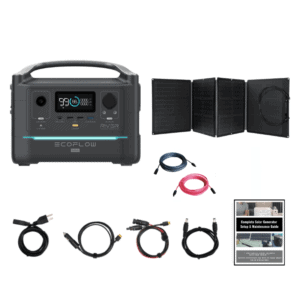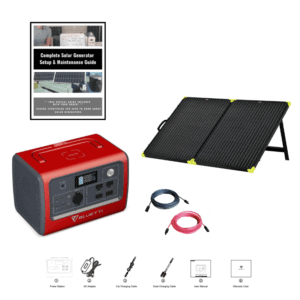Goal Zero Yeti 400 Review
Written by qualified solar engineer Aniket. Last updated:
Page Contents
- Three-way output
- Multiple charging methods
- Display panel
- Chainable
- Built-in pure sine-wave inverter
396Wh or 33Ah capacity at 12V
Weight: 29 lbs. (13.2 kg)
Dimensions: 10.25 x 8 x 8 in (26 x 20.3 x 20.3 cm)
Operating Usage Temp: 32-104 F (0-40 C)
Our Verdict
The genuinely portable Yeti 400 by Goal Zero is a rugged and practical battery unit. Its 396Wh AGM lead acid battery provides enough to charge a host of devices such as laptops, tablets, TVs, and even mini-fridges. For those who need a few days of moderate energy supply for camping or other outdoor needs, this is a perfect companion.
This Goal Zero Yeti 400 review will look at the key features that separate it from basic 33Ah batteries. This includes its variety of inputs and outputs, its near-perfect display, and a sturdy build. While 33Ah may not be ample for some seriously long adventures, it is relatively lighter and does cover the essentials. For those that are new to solar, this an especially great product.
Compatibility
At a cost that is more than twice of regular 33Ah batteries, the Yeti 400 is almost obliged to offer amazing features. Its compatibility proves to be the most important feature that justifies its cost. The Yeti 400 comes with a single pin input and can be charged in several ways. It can be charged using a wall unit at home, which will need the AC wall charger. The 2-piece wall charger comes as standard with the product. This needs about 5 hours to charge the battery fully, assuming a standard wall output of 75W. Alternatively, the Yeti 400 can be charged by a car charger and will require 12-13 hours for the same.
The third and the most interesting input is via solar panels, where the Yeti 400 shows off its true portability potential. It has a single pin solar charging input. The solar panels should have a rated output of 14-22V. The Yeti 400 is perfectly compatible with Goal Zero’s array of portable solar panels. The charging time depends on the rated power capacity of solar panels.
Depending on the sunlight, the Boulder 50 portable panel will require 13-32 hours to fully charge the unit, while on the other end of the range, the Boulder 200 Briefcase will require only 4-8 hours for the same. The only catch with the largest sized Boulder 200 Briefcase is that it comes with an Anderson pole pin and will require a connector cable with an 8mm output pin.
On the output side, there are two 5V USB ports that can be used simultaneously for charging mobile phones and tablets. There is also a 6mm, 12V output port and the AC output port. The AC port uses an in-built inverter that converts the DC current to a 110V AC one.
Durability
Another department where the Yeti 400 justifies its ‘portable’ tag is its durability. The sealed battery is securely encased in the housing. The shell looks as well as feels robust and can sustain some mild falls as well as transportation bumps.
The unit does not have any protruding elements such as the terminals of regular batteries, or permanently attached wiring that could lead to entanglement and damage. There are hardly any weak sections on the entire cubical structure. Even the handle is snugly fitted so that it stays in the same plane as the top surface.
The vertical edges are blunted and reinforced with serrated plastic patches. These should resist impacts and possible damage on the corners. The front houses a small slatted area for cooling but the dimensions are optimum in order to avoid breakage. The Yeti 400 sits on four relatively broad legs that avoid easy slipping or tilting on small gradients.
Ease of Use
A regular battery with two terminals would require you to make connections in four different places using two wires. For AC devices, that would turn to six connections by including an inverter in between. Along with the messy wiring, there is also the possibility of incorrect connections. The Yeti 400 solves this issue by having ports that make using it as simple as any everyday domestic appliance.
The almost comprehensive display unit on the front displays charging level, input power, and consumption in real time. The charging and discharging can be done simultaneously. The multiple input and output ports on the front would have been confusing, but clear markings on each one of them makes it far simpler to connect it to input or output items such as solar panels or laptops.
Besides default single unit usage, this power station has chaining ports which are easy to use. You will require cables with Anderson poles to chain multiple 33Ah units with the Yeti 400. This is fairly easy and can be done in a matter of a few seconds, once you have done it yourself once or twice.
Features
Among the most impressive features of the Yeti 400 is the possibility of powering a maximum of seven devices at a time. Additionally, a well-designed display with fantastic outdoor readability gives precise and necessary information to the user. The charging power and discharging power are displayed on either side of a state-of-charge indicator. This gives a clear idea of how much longer the device may take to charge/discharge and which will happen first. The display features are an important upgrade over the younger brother Yeti 150.
It is wrong to call the Yeti 400 a ‘battery’, as batteries can only produce DC power. This unit, however, has the much-needed AC power output, as it employs an inverter inside. The inverter is a pure-sine-wave type, which means it gives exactly the kind of power that a wall outlet at home does. On turning the AC output switch on, the display indicates a small power output reading. This suggests there is some natural current loss in the inverter. It is hence advisable to ensure the switch is turned off when not in use.
This Yeti 400 goes with the more traditional lead-acid type of battery but that does not affect its reliability. If you need larger sized battery units infrequently, Goal Zero has made such ease of use possible. The Yeti 400 can be chained with other Yeti generators to increase the Wh capacity. This is essentially a parallel connection to keep the voltage constant while maintaining the compatibility.
If the Yeti 400’s features at its cost don’t seem to convince you, you will be pleased to read that we reviewed more of this year’s best solar generators that might be more to your liking.
Design
One look at the Yeti 400 and it immediately exudes a sense of toughness. Its patched edges evoke the feeling of an off-road SUV with side-cladding. The black and metallic grey colors complement each other without being gaudy. Goal Zero has gone with its characteristic lime green color for the handle, stoppers, and the tiny label in front that reads ‘YETI 400’. The handle is compact yet ergonomic.
The front panel seems a bit crowded with all the ports, but it cannot be helped. Nevertheless, Goal Zero has done a good job to make it look less cluttered by having colored borders for groups of ports. The input port has a blue one, while the three output ports sport green, red, and white. The border’s thickness is minimal and does not overpower the overall design. Pressing the buttons placed above each group of ports turns the display on. This makes the device ready to pump the required power.
The overall design of the Yeti 400 is quite boxy, and there is a feeling of ruggedness while handling it. None of the dimensions are over a foot, making this a quite compact device, requiring small volumes for storing or transporting. It can fit nicely in a corner of your car’s boot while making space for other things.
Portability
It would not be an overstatement to say that the Yeti 400 must have been built while keeping portability as the first priority. Though the current state of battery technology does not allow it to be extremely light; it manages not to add significant weight over the battery. 13 kg might not exactly sound light, but for a battery station that can power your mobile phone 30 times, it is worth the weight.
The compactness, as mentioned previously, and the superior build quality make it less vulnerable to shocks and minor falls. A major plus would have been an IPX7 rating to render the device water resistant.
What We Like
There are a number of options in portable energy storage units, but Goal Zero’s Yeti 400 is assuredly one that doesn’t compromise on quality and features. It does cost a little on the higher side, but compensates for the pricing on other fronts. It is strong, versatile, and compact. With a solar panel or two, it can facilitate a truly off-grid existence for significant durations. The option to chain with other units makes it even more attractive in this aspect. If you are still thinking about scanning through other options, we reviewed a few more of the best solar generators which may help you make a confident decision. As far as the Goal Zero Yeti 400 is concerned, it seems to tick all the right boxes, and it looks like it’s here to stay.
Pros:
- Compact, rugged, and aesthetically pleasing
- Multiple ways to charge including home (AC) or solar (DC)
- Seven types of output ports of three types including DC and AC
- Easy to use, despite of multiple features
Cons:
- High cost, could have been lower by about 25%
- Water resistance could have been a great addition
Here Are The Alternative Kits:
We hope you liked this article. Please rate it or leave us a comment.
Average rating 5 / 5. Vote count: 4
No votes so far! Be the first to rate this post.












